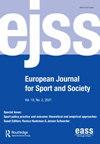APPROACHING THE PATELLOFEMORAL PAIN SYNDROME THROUGH PHYSIOTHERAPEUTIC METHODS VERSUS KINETOTHERAPY
IF 1
Q2 HOSPITALITY, LEISURE, SPORT & TOURISM
引用次数: 0
Abstract
Considering the importance of the knee joint in everyday life, both for carrying out daily activities and for carrying out professional activities, we can conclude that its recovery is extremely important. The production mechanisms of the femoro-patellar syndrome are multiple, and this requires the implementation of a recovery program as effective as possible, based on the most accurate and detailed assessment. Regarding the modification of the activity, we are left with a series of contraindications such as; avoiding deep bending of the knee against resistance. Maintaining an adequate body mass index should be part of any anterior knee pain management program. Muscle toning exercises are recommended without crossing the painful threshold, performed especially in a closed kinetic chain, and hydrotherapy offers numerous benefits in performing movements by reducing joint stress. As far as physiotherapy methods are concerned, they can be considered very important in reducing pain in patients with femoro-patellar syndrome, because with their help we can implement the kinetotherapeutic exercise program early and without the presence of pain. In the present paper, two of the most frequently applied protocols for patients diagnosed with femoral-patellar syndrome were tested on 2 different groups of patients. Although the results are beneficial for patients through the prism of both programs, we can still state that the simultaneous use of kinesiotherapy together with physiotherapy could provide promising results for patients diagnosed with this syndrome.通过物理治疗方法与运动疗法治疗髌骨股痛综合征
考虑到膝关节在日常生活中的重要性,无论是进行日常活动还是进行专业活动,我们可以得出结论,膝关节的恢复是极其重要的。股髌骨综合征的产生机制是多种多样的,这就要求在最准确和详细的评估基础上实施尽可能有效的康复方案。关于活动的修改,我们留下了一系列禁忌症,如;避免膝盖因阻力而深度弯曲。保持适当的身体质量指数应该是任何前膝关节疼痛管理计划的一部分。建议在不超过疼痛阈值的情况下进行肌肉调理运动,特别是在封闭的动力链中进行,水疗通过减少关节压力在执行运动方面提供了许多好处。就物理治疗方法而言,它们对于减轻股髌骨综合征患者的疼痛非常重要,因为在它们的帮助下,我们可以在没有疼痛的情况下早期实施运动治疗计划。在本文中,对诊断为股髌骨综合征的患者进行了两种最常用的治疗方案,并对两组不同的患者进行了测试。虽然通过这两个项目的棱镜,结果对患者是有益的,但我们仍然可以声明,同时使用运动疗法和物理疗法可以为诊断为这种综合征的患者提供有希望的结果。
本文章由计算机程序翻译,如有差异,请以英文原文为准。
求助全文
约1分钟内获得全文
求助全文
来源期刊

European Journal for Sport and Society
HOSPITALITY, LEISURE, SPORT & TOURISM-
CiteScore
3.30
自引率
4.20%
发文量
17
 求助内容:
求助内容: 应助结果提醒方式:
应助结果提醒方式:


